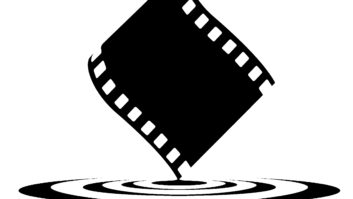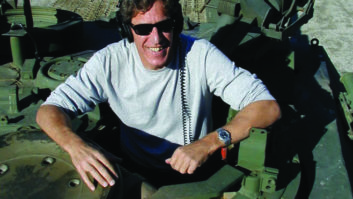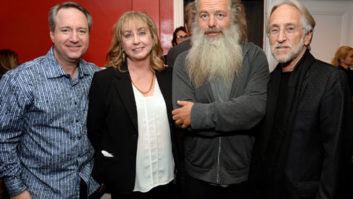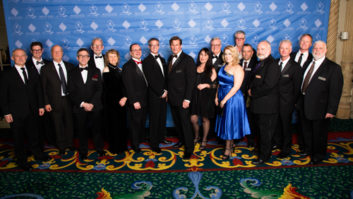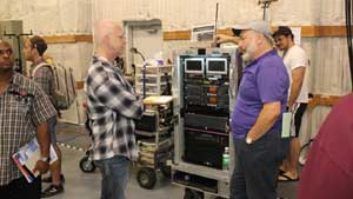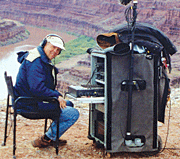

Production sound mixer Jeff Wexler brings to his work a uniquely practical combination of traditionalism and forward-thinking. With more than 30 years of experience in the movie business, he’s amassed a treasure trove of knowledge on classical film recording techniques. He’s also a digital pioneer. Acknowledged as the first to introduce DAT and the first on the West Coast to introduce Zaxcom’s Deva hard disk recording to production, he overcame the film industry’s notorious resistance to change simply by using the technology and demonstrating its benefits. Opinionated, but also open-minded, outspoken but subtle above all, Wexler is passionate about his chosen career of filmmaking and making great movies.
Wexler on location in Moab, Utah, for City Slickers II
Wexler literally grew up on movie sets. His father is noted cinematographer Haskell Wexler (One Flew Over the Cuckoo’s Nest, Coming Home, Who’s Afraid of Virginia Woolf?), so the young Jeff was actually riding around on camera dollies at age two. Wexler freely admits that the respect his father achieved opened doors, but he was determined to make his own way, ultimately choosing sound rather than picture as his avocation. Although he originally eschewed a career in the movie business entirely, a summer job working on Harold and Maude with director Hal Ashby changed his mind. Once set on a career in sound, he dived in with both feet and never looked back.
Wexler’s illustrious career crosses genres and has included, among many other films, The Last Samurai, Almost Famous, Fight Club, As Good As It Gets, Jerry Maguire, Independence Day, Ghost, Throw Momma From the Train, An Officer and a Gentleman, 9 to 5 and Bound for Glory.
How did it happen that you chose sound mixing for a career?
I had a master’s degree in sociology and had pretty much decided I was going to teach when Haskell got me the summer job working on Harold and Maude — in the art department, actually. To my surprise, I loved every minute of being on the set and participating in creating something that ended up, at the dailies, right there on the screen. So I made the decision to give the film business a try. Since I’d always been a gadget freak and interested in equipment and technology, I knew it had to be in camera or sound. I didn’t want to try to fill my father’s very large shoes, so by default I chose sound. As it turned out, I had a real affinity for it.
How did you learn the craft?
After Harold and Maude, I got offered a job on a Gene Corman film — Cool Breeze. I told them I was a sound mixer — even though I wasn’t — so I had to learn very quickly. Fortunately, I’d absorbed enough from being on sets all those years that I knew how to look like I knew what I was doing! Also, on one of his first jobs as a cameraman on that picture was Andy Davis, who is, of course, now a director [Under Siege, The Fugitive, Holes]. Andy had the idea that I should hire his friend, Tomlinson Holman [co-founder of THX, now professor of film at USC], who was a film teacher, as my boom operator so that I could learn from him. Which is what I did. [Laughs] Tom was not the greatest boom operator, but he was a terrific teacher. By the end of the film, I had a good grasp of the equipment. We did, by the way, a very good job on the sound, and I was offered another film, then another.
Often, people in film tend to be expert in their areas, but not too knowledgeable about the rest of the production. Probably because you were, from an early age, surrounded by the business, you have a different perspective.
Some people get into motion picture sound through audio engineering or through classes in electrical theory or acoustics — all valid approaches. It was different for me. I came into the business with an understanding and a love for the process of making movies first. Then, I decided that my particular place would be sound. Knowing that we’re all just part of the process may have given me a fuller experience.
In some ways, the business encourages people to be limited in their focus. It helps in terms of managing projects: If you very specifically define people’s tasks, things will, hopefully, go more smoothly. But the way that hurts is that people often have more to offer. That was one of the beauties of working with Hal Ashby. He was one of the most collaborative people of anyone I’ve worked with, open to suggestions and ideas from anyone and very unthreatened about it. He told me once that he’d be a fool to think he had all the answers. I was lucky to work with him, and it helped me to do sound because it made me feel involved in the whole project. That’s how I’ve continued to work. I prefer to work with directors who value my input beyond what microphone is being used.
You’ve mentioned in previous interviews that you like to be involved in pre-production. Is that common for production sound people?

On The Last Samurai shot in New Zealand, Wexler was completely mobile in a Kawasaki “Mule.”
It’s less and less common. First of all, they’re often hired at the last minute because the green light was only given on the picture at the last minute. And, of course, they don’t want to pay people on the crew any more than they have to. So it’s difficult to get involved early. But most of my projects are with directors I’ve worked with before who want me to be involved. Cameron Crowe used to call me when he was writing a script to have discussions on how we’d do something. Now he probably wouldn’t; we’ve done so many movies he knows we would just, together, develop the best way to do it. But particularly with people I haven’t worked with before, I like to go on location scouts — it’s my first chance to see how the rest of the crew approaches the work. And often I’ll sit in on the first actors’ table read to get a sense of what the performances are going to be like.
I’m very lucky that I’m included on these things. But also, I’ve demonstrated many times over the amount of time and money that can be saved by, and how the quality of the project can benefit from, early involvement. It goes back to compartmentalizing. From a managerial standpoint, they don’t want people “making waves.” But I don’t consider being involved in pre-production — making educated suggestions about what might be a better way to do things — to be making waves. I think it’s helping to make a better movie.
How aggressive are you about making suggestions on the set?
[Laughs] I used to be much more aggressive. I have this reputation of bolting up from the sound cart, tearing off my headphones and saying, “Totally unacceptable!” But I’ve learned over the years that that sort of grandstanding never accomplishes anything productive. It just causes animosity toward the sound department. Flamboyance went out of my repertoire years ago. Now I deal with things quietly, usually with a conversation early on, where we set rules and protocol and whether if a director is getting into trouble and I have a solution I should bring it to him or her. Now all that communication is done with brief shorthand — sometimes just a glance.
Let’s talk about the boom operator’s role.
Boom is absolutely the key position in the production sound department. The sound department is typically three people: production sound mixer, first boom operator and utility sound person, who’s often a fully qualified second boom operator. The sound mixer is the department head in terms of responsibility. For example, I generally get the jobs, break down the script and make decisions about how we’re going to do things on the set, et cetera. But the actual act of recording production sound is totally in the hands of the boom operator.
How so?
The choice of microphone, the way it’s used and the way the boom is operated are the most important factors in whether you’ll have good sound or not. It’s not the mixing panel or the frequency response of whatever processors or recording medium are used. The microphone and boom have to be operated properly and skillfully, with a high degree of creativity.

Wexler ready to jump on the charter plane for Elizabethtown
Here’s an anecdote. I’ve worked with my boom operator, Don Coufal, for over 25 years. On one film, during dialog predubs, the very experienced re-recording mixer asked me why our tracks never have camera noise problems. I said, “Well, that’s Don.” The mixer responded, “What does DON stand for? Digital something?” And I answered, “No, that’s my boom operator!” He was actually quite surprised that a boom operator could have any effect on whether or not there was camera noise on the tracks.
Boom operators notice all of the sounds going on.
They have to be aware of all the other things the mic is picking up. Instead of placing the mic in a classic position, they might mike an actor off to the side. They have to be listening with an experienced ear and have the ability to put the microphone in a place where it picks up the voice in a beautiful way and gets rid of the things you don’t want to record. In production sound, it’s a constant battle to record the things you want and not the things you don’t. Even though there are a tremendous number of tools available now to post-production, you still can’t easily get rid of the things you don’t want later. The place to fix something is on the set, where that mic is placed.
Has it gotten easier or more difficult for you to hear on sets?
As sets have gotten more and more chaotic, it’s became more difficult to do all of our work. There are more elements, less time. I don’t mean to be negative — because I was once someone doing his job for the first time — but a lot of people are doing their job for the first time without an understanding of the discipline and with the protective arrogance that can sometimes accompany that. Coming from music videos or big effects movies, people sometimes don’t understand what can be done, often quite easily, to get good production sound. Which is unfortunate, because without it, a lot can be lost in terms of performance. ADR is a great tool, but it’s not always the best solution and it’s often problematic. People find that out on the ADR stage, months later, when they’re trying to get the actor back who’s gone on to shoot a movie in Prague.
Moviemaking is more complicated now. You may have a director saying, “We’re going to shoot with four cameras and I want to shoot the musical number over there at the same time that we’re shooting pickups from the scene we did yesterday over here with the B camera.” That forces sound to use a lot of tracks to make sense of it. It’s gotten so much easier to capture a lot of stuff — with a lot of cameras and a lot of tracks — that some of the focus and discipline has gone away.
There was a recent interview in the Editors Guild magazine with people who’d worked with the likes of Billy Wilder. They talked about how they used to receive 6,000 feet of dailies a day with no real questions about what to do with it. Now they can get 30,000 feet of dailies, and once it’s gone through, they don’t know what to do with it, because it’s shot from multiple cameras and the B camera angle was compromised, or the screen direction looks were wrong and things won’t cut smoothly. We’ve gained the ability to shoot a lot of film and record a lot of tracks, but we’ve lost the sort of focus that needs to happen before you film.
How do you break down a script for sound?
Many people don’t realize how important the script is to sound. I may have a draft of the script before we start, as well as a shooting script, so that I can anticipate where there may be difficulties. For example: Our main character goes over to the ice machine in a hotel vending area, gets ice to put in a glass, then does a five-page dialog scene. I’ll note that on the day we shoot that scene, we need control over the ice machine. We don’t want one that’s hard-wired and can’t be turned off or it will contaminate five pages of dialog. My note goes on to the production manager who, when he makes the deal with the hotel to shoot that location, ensures that we have a way to turn the machine off.
If there are scenes with music, you have to get with the music department and maybe the composer. Will they pre-record music and shoot to playback, or do they want to record some of it live? Sometimes my notes may go to wardrobe. Ngila Dickson, the costume designer on The Last Samurai, and I had a conversation prior to shooting. She’d done massive amounts of research about the construction of the armor and its materials, and it was my job to record dialog that wasn’t contaminated by the sound of the various materials that she used to create the armor, which weren’t authentic.
Do you record sound effects?
Dialog, of course, is the primary charge. But when I’m on the set, I try to record anything and everything that might be useful as much as I can. People in post-production seem to appreciate anything you can give them. Certainly in terms of recording wild sound and various sound effects, I always record what I know will be needed to put together a dialog scene.
What’s your current technical setup and how many tracks do you record?
I use the [Zaxcom] Deva; I’ll be using the new Deva IV, an 8-track nonlinear production recorder, that will replace my old Deva II 4-track machine. I’m still old school in that I record as few tracks as possible; I treat the work as if we only had one track. But I do take the elements that go into my mix and split them into isolated tracks so that someone later can use them for a different mix or for discrete tracks.
You mix to mono?
Yes. Even if I’m using several mics, I’ll mix them to track 1 of the Deva. Picture editorial demands one track — possibly two — where they can get on with the process of editing without going into lots of tracks. The Deva is full 48 kHz, 24-bit, uncompressed — about the highest quality available at this point. It will record at 192, but the rest of the chain of events doesn’t support that yet.
Do you use any limiting or compression?
I do manual compression — gain riding. Even with the dynamic range of digital, a certain amount of compression is necessary. I apply some manually; a lot more is added in post-production. For example, with dialog, there are often performances where there’s a drop in level at the trailing end of sentences. I’ll help that up a bit so that at dailies, everything can be heard the way they need it to be. I’m not just laying down tracks so that somebody else will have to do everything to it. But with the multitracks, I love that I’m not tying anybody’s hands later.
What mics do you prefer?
I use 48-volt, phantom-powered Schoeps condenser microphones — the hypercardioid CMC 41s. I used to use much longer, more directional microphones, as many people in film do. But I discovered a long time ago, on the film Being There, that a hypercardioid or cardioid with a gentler, less-directional pickup — although it buys a lot more background sound — gives a much more natural, pleasant and usable sound. We did tests with a shotgun mic and with the Schoeps and the Schoeps sounded like the real world. You heard the background, but in a coherent way that made sense. The extremely directional mics cut down the level of the background, but also negatively affected the sound of the voices.
Your preamps are in your console?
Yes. My console is an Andy Cooper analog design, a Cooper 208, with eight inputs, four outputs and direct outs. I go into the Deva analog line in. Andy’s preamps are analog and transformer-based and about the best-sounding. Other people are using digital consoles, but I still like certain parts of our work to be analog.
You just finished working on Elizabethtown, another Cameron Crowe picture. What was that like?
It’s a terrific movie and it’s wonderful working with Cameron. He values the people working with him in such a way that you go out of your way to do things. He does, of course, have a unique way of working with music. Music is at the core of his existence — he plays it on the set all the time, even between sentences of dialog. Often, rather than giving the actor a direction, he’ll play a piece of music to get the reaction he wants. He has his hands on the button, and he’ll play a piece right in the middle of a scene, which can be disconcerting for actors who haven’t worked with him before!
We’ve gotten very skillful at preserving the dialog. Previously, he brought in hundreds of CDs, but on Elizabethtown, we had the benefit of PowerBooks, iPods and instant access, which made him even more aggressive about finding the absolutely perfect piece of music for a scene!
Any parting words about your job?
The most important thing in the work that we do is the respect between people. Problems are solved by good working relationships. The equipment I use is very carefully thought-out, but I don’t get a job because I use certain equipment. The end result is what’s important. Equipment comes and goes; next, we might be uplinking directly to satellites! Who knows? If you haven’t established the necessary skills, personal relationships and clarity of thought in your approach to your work, all the latest equipment won’t amount to anything.
Maureen Droney is Mix’s L.A. editor.

Production sound mixers are “the workhorses of the film sound world,” says Blair Jackson. Click here to read his 2002 interview with some of the industry’s finest.
Read Jeff Wexler’s Mix feature on Deva and hard disk recording,here.

